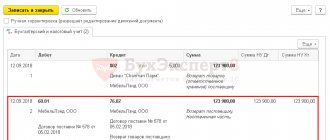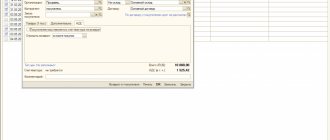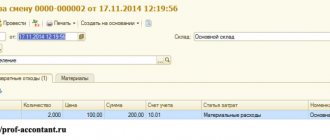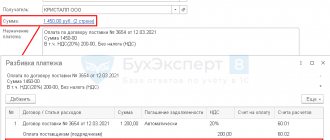Features of returning money to the cash desk by an accountable person
Organizations (IP) can issue funds on account in two ways:
- transfer to an employee’s account or corporate card (letter of the Ministry of Finance of the Russian Federation dated October 5, 2012 No. 14-03-03/728);
- issuing cash (directive of the Bank of Russia “On the procedure for conducting cash transactions...” dated March 11, 2014 No. 3210-U).
If an employee has not used all the accountable money issued to him, he must return it within the time period established for this by the employer (clause 6.3 of instruction No. 3210-U).
The amount of the refunded amount is determined based on the results of verification and approval of the advance report on the amounts spent. Such a report must be drawn up no later than the number of working days approved by the organization from the expiration date for which the money was issued (clause 6.3 of instruction No. 3210-U).
ATTENTION! From November 30, 2020, the requirement to submit a report within 3 working days has been canceled.
From November 30, 2020, other changes to reporting and cash register came into effect. ConsultantPlus experts spoke in more detail about the innovations. Get trial access to the K+ system and go to the review material for free.
The issuance period is fixed in the application drawn up by the employee for the issuance of an advance, or in the employer’s administrative document on the issuance of money on account. From 08/19/2017 (instruction of the Bank of Russia dated 06/19/2017 No. 4416-U), the completion of an application by an employee is no longer a mandatory condition for the payment of accountable amounts. It can be carried out on the basis of an administrative document of the head of the legal entity (or individual entrepreneur).
You will find an example of such a document in ConsultantPlus. Trial access to the legal system is free.
IMPORTANT! Directive No. 3210-U applies its rules only to the rules for issuing and returning funds in cash. For non-cash payments for accountable amounts, its provisions do not apply, and an employer using this method must approve the procedure for settlements with accountables by an internal document.
Tax consequences of late return of imputed amounts
In accordance with paragraphs. 1 clause 3 art. 24 of the Tax Code of the Russian Federation, tax agents are obliged to correctly and timely calculate, withhold from funds paid to taxpayers, and transfer taxes to the budget system of the Russian Federation to the appropriate accounts of the Federal Treasury. For failure to fulfill or improper performance of assigned duties, the tax agent is liable in accordance with the legislation of the Russian Federation (clause 5 of Art.
24 of the Tax Code of the Russian Federation). Thus, the question of whether the employee has income for the purposes of calculating personal income tax in the situation under consideration is ambiguous. If the organization proceeds from the absence of grounds for recognizing the fact that the employee has income for the purposes of calculating personal income tax, then it is possible that it will have to defend its position in court. At the same time, with the release of the Resolution of the Presidium of the Supreme Arbitration Court of the Russian Federation dated 03/05/2013 N 13510/12, we have no confidence that the court will take the side of the organization; the opposite outcome of the case seems more likely (which, in turn, implies the responsibility of the tax agent).
However, there are examples of court decisions with a different point of view. Thus, from the decisions of the Federal Antimonopoly Service of the Volga District dated September 22, 2009 N A55-1433/2009, and the Ural District Federal Antimonopoly Service dated December 19, 2008 N F09-9428/08-C2, it follows that if supporting documents for the purchase of goods are missing or are drawn up in violation of legal requirements, then the amounts given to the accountable person for business expenses form the income of an individual subject to personal income tax. In the decisions of the FAS East Siberian District dated 08/10/2005 N A19-31904/04-45-Ф02-3758/05-С1, the FAS North-Western District dated 12/04/2006 N A05-5905/2006-29, the courts came to the conclusion that that accountable amounts not deposited into the organization’s cash desk are the employee’s income and are subject to personal income tax.
According to the Ministry of Finance of Russia, as well as the tax authorities, if a person fails to return accountable amounts, as well as in the case of failure to provide documents confirming expenses incurred, the accountable person will have income in cash, taken into account for the purposes of calculating personal income tax (letter from the Ministry of Finance of Russia dated September 24. 2009 N 03-03-06/1/610, Federal Tax Service of Russia for Moscow dated 10/12/2007 N 28-11/097861, dated 03/27/2006 N 28-11/23487). Return of money issued for reporting to the cashier
Is it possible to return accountable funds to a current account?
Current legislation does not prohibit employees from returning accountable amounts to the employer’s bank account. However, in order to avoid disputes with tax authorities, it is necessary to establish in an internal regulatory document the possibility of reporting persons returning unspent funds to the company’s current account or to record such a return option in an application (order) for the issuance of advance amounts.
To identify the transfer, the employee making the transfer must indicate in the payment purpose that he is returning the accountable amounts.
And yet, the optimal way to return accountable funds, eliminating any disagreements with controllers, is to the enterprise’s cash desk.
general information
The job responsibilities of some employees require handling cash.
The head of each company must draw up a list of persons to whom it is possible to issue accountable amounts necessary to solve production problems that require material costs. This information should be reflected in one of the sections of local acts regulating the procedure for issuing money and returning the remaining amount to employees.
Accountable amounts are funds allocated to employees to solve production needs. They can be highlighted:
- on a business trip;
- to make a purchase for the business needs of the company.
Money is not always spent in full. The remainder of the funds must be returned to the cash desk, and the money spent must be reported and documented to justify your expenses. It is worth noting that the employee can issue a refund not only through the cash register. He has the right to express a desire to withhold the surplus from his next salary or independently arrange a transfer from a personal bank card. However, most often the return of accountable amounts is carried out through the cash desk of a business entity.
How is the amount of return of funds taken into account reflected in accounting?
The company, having received accountable amounts from the employee, reflects the following entries in accounting:
- Dt 50 Kt 71 - return of cash to the cash desk;
- Dt 51 Kt 71 - return of accountable amounts to the ruble bank account of the enterprise;
- Dt 52 Kt 71 - return of the sub-report to the company’s foreign currency account;
- Dt 94 Kt 71 - reflection of the debt of the accountable in case of non-repayment of the amounts issued by him.
For information on what to do if an employee does not have enough accountable funds, read the article “ What to do if an accountable person has spent his money? "
How to return funds from the account if an employee no longer works for you
If the current employee does not return the accountables, you will find recommendations for further actions in ConsultantPlus. Get trial access to the system for free and go to the Ready-made solution.
In a situation where the employee did not return the accountable money and quit, you can do the following:
- If the employee has not yet been paid, then the debt can be withheld from his salary, subject to the decision of the manager and the consent of the employee. In this case, the withholding should not exceed 20% of the salary (Article 138 of the Labor Code of the Russian Federation).
- If all settlements with the employee are terminated or he does not agree with the amount of withheld amounts, the debt can only be collected through legal proceedings.
To find out whether it is possible to delay the payment of funds due to an employee upon dismissal if he has not returned the accountable amounts, read the material “What payments are due to an employee upon dismissal”.
What is an account
Every commercial company is created for the purpose of making a profit. At the same time, she makes various transactions every day, the accounting of which is very easy to get confused without a clearly organized accounting structure. Moreover, according to Art. 2 of the Law “On Accounting” dated December 6, 2011 No. 402-FZ, all legal entities are required to maintain accounting records.
It is organized through continuous documentation of each business transaction and carries several functions:
- informational;
- control;
- feedback;
- analytical.
Find out who is responsible for organizing accounting.
Accounting provides information about the financial and economic state of affairs to both internal (managers, management, founders, etc.) and external users (controlling, fiscal and other government agencies).
One of the accounting methods is double entry using accounts approved by Order of the Ministry of Finance of Russia dated October 31, 2000 No. 94n (for commercial structures).
You can familiarize yourself with the chart of accounts in the article.
Double entry is an accounting entry that reflects a business transaction using 2 offsetting accounts. Each account has a specific number, structure and characteristics. In this case, the same amount is recorded in both accounts.
Example 1
Consider the operation “Cash in the amount of 20,000 rubles. handed over from the cash desk to the bank.”
Based on its economic meaning, we select the appropriate corresponding accounts: 50 “Cash”, 51 “Settlement accounts”.
Funds are sent from the credit of account 50 to the debit of account 51. This operation is recorded by a cash receipt order, a bank statement, the counterfoil of an advertisement for cash deposits and the entry: Dt 51 Kt 50 - in the amount of 20,000 rubles.
This means that the balance at the bank servicing the enterprise increased, but at the cash desk decreased by the same amount (RUB 20,000).
To use accounts correctly, you must not only choose them correctly, but also know what type they are.
Accounts can be active, passive and active-passive.
Active accounts reflect the assets (property, debts, etc.) of the enterprise and have only a debit (positive) balance. An increase in assets is recorded as a debit to the corresponding account, a write-off is recorded as a credit.
The main active accounts are presented in the table:
| Check | Definition |
| Fixed assets | |
| Intangible assets | |
| Materials | |
| Animals in production | |
| Production | |
| Semi-finished products | |
| Goods | |
| Finished products | |
| Cash register | |
| Current accounts | |
| Currency accounts | |
| Own shares |
Liability accounts indicate the sources of the company's assets and have only a credit balance. These include, in particular:
| Check | Definition |
| Depreciation of fixed assets | |
| Depreciation of intangible assets | |
| Extra charge | |
| Loans | |
| Settlements with personnel | |
| Authorized capital | |
| Reserve capital | |
| Extra capital |
Active-passive accounts include accounts that have both a debit and a credit balance. For example, if account 60 “Settlements with suppliers” has a credit balance, it means that the company owes the counterparty for supplies or services supplied. If we paid an advance to the supplier, it means that the counterparty already owes our company. This transaction has a debit balance.
| Check | Definition |
| Settlements with suppliers | |
| Settlements with customers | |
| Taxes and fees | |
| Accountable persons | |
| Retained earnings (loss) | |
| Profit/loss |
On account 62, an unpaid receivable may arise, which in some cases is considered doubtful, because may not be paid by the buyer. In order to correctly reflect such debt on the balance sheet, each organization is required to create a reserve for doubtful debts.
Find out how to correctly record entries for doubtful debts in the ConsultantPlus ready-made solution by getting trial access to the system for free.
Accounts also have analytics for subaccounts. For example, for account 10 these will be accounts 10.1 “Raw materials”, 10.2 “Purchased semi-finished products”, 10.3 “Fuel”, etc.







